

Make-up for the camera: how to become electronically invisible
Facial recognition systems track your every move. How can you evade this surveillance without breaking the law? We have made the attempt.
When you point your mobile at a face, a square or circle appears around the eyes, mouth and nose. The machine identifies you as a person with a face. The smartphone thing may be harmless, but large companies like Siemens sell surveillance camera systems with facial recognition to anyone who can afford them. Police, football stadiums, fashion shops on the corner. Escaping these machines is difficult, but not impossible. The experiment shows: The more conspicuous you become to people, the more invisible you become to machines.
The experiment in detail
Models Lea Krummenacher and David Lim are asked to look into the camera of the Vivo Nex S, one of the most modern smartphones on the market, in perfect studio lighting. The face recognition - a yellow rectangle - is not supposed to appear.
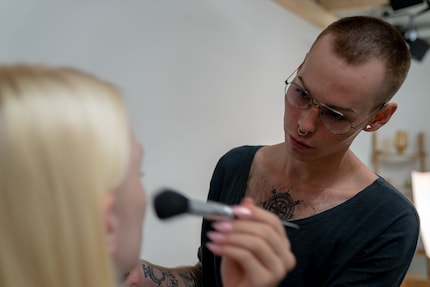
Facial recognition works as follows: The artificial intelligence behind the electronic eye searches for eyes. Or rather, two light-coloured areas with something dark in the middle. This also works in the profile with just one eye, which is why facial recognition works with one or two "light with dark in the centre". But not with three, as there are no people with three eyes. A first point of reference.
The camera also searches for other lines. A vertical line as a nose, a horizontal line as a mouth. Either a nose in profile or symmetry in the frontal view. The theory: If we give the camera shapes, contrasts and colours that it would not expect to see in a face, then the yellow rectangle will not appear. Then the camera in the stadium might not recognise you either.
The Dazzle concept
The idea we are pursuing is called Dazzle. The most eye-catching camouflage of all time was invented during the First World War. Back then, armies painted ships with confusing patterns so that submarines with their periscopes couldn't be sure whether there was a ship or whether it was waves and clouds. In calm waters people are hard to fool, but in battle, when every torpedo counts, a soldier wants to be sure that there really is an enemy ship and exactly where it is and in which direction it is travelling. All of this is made as difficult as possible by Dazzle.

In 2012, artist Adam Harvey took the concept of modern surveillance cameras and created make-up and hairstyles designed to guarantee digital invisibility. A lot has happened in the technology industry since then. Cameras have become smarter, computer systems faster and more intelligent. Does this still work? And if not, how far do we have to go to ensure that the person in front of the camera is not recognised?
The one-eyed Lea
How to break the lines on the face. To do this, make-up artist Marc Moser uses lipsticks. He draws three lines over Lea's right eye and three dots on her right cheek. He makes half of her lower lip black, leaving the rest natural. He then styles her light blonde hair over half of her face.
The Vivo Nex says: There's no human in the picture. Even in profile, the Nex doesn't recognise Lea. Three dots and three lines and a bit of lipstick are enough.
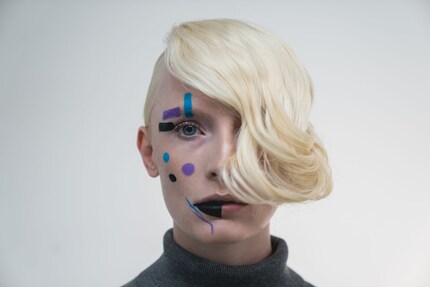
But if Lea moves her hair even a centimetre to the left, revealing her left eye, the camera will strike. Because then she has found the straight line of the nose and can see a bit of eye. The electronic brain calculates, abstracts the make-up and the yellow rectangle appears. The cameras therefore also look for symmetry and if this is found, the system behind the camera can see past the make-up and recognises the face.
The three-eyed David
In David's case, Marc Moser tries to exaggerate the lines on his face so that the camera no longer recognises it as a face. He draws a vertical black line on David's nose, with white highlights next to it. A white spot over the upper lip on the right, black strokes on the right cheek and a white line between the eyelid and eyebrow.
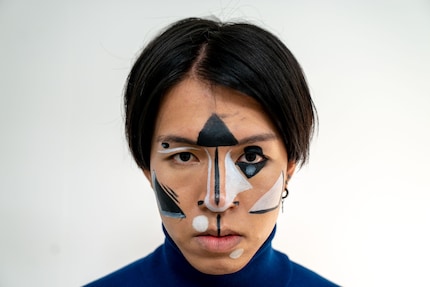
A yellow rectangle appears.
Marc surmises that the symmetry of David's face allows the camera to miss the make-up.
"Then I'll just have to make a mess of his left eye," he says with a laugh.
A triangle under the left eye is supposed to fix it. Plus a shapeless spot on the upper eyelid. There's a bit of a "Clockwork Orange" aesthetic. But the camera still says: there's a person.
Just between the eyes
So what makes Lea's look unrecognisable, but David is obviously human? Is it because parts of her make-up resemble her eye colour?
"Unlikely," says Marc, "because David's dark eyes could fall into roughly the same category as his black make-up in front of the machine."
.
We can't say exactly what works how well during the whole experiment. After all, a Samsung A5 from 2017 quickly stops recognising Lea or David as human. But the Vivo Nex is cleverer. An iPhone 5 recognises David, but not Lea.
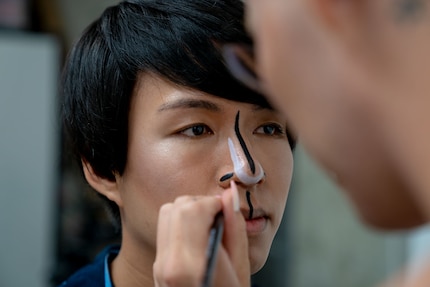
A little trial and error shows: The Vivo Nex's camera places great emphasis on the area between the eyes. This is where the line of the bridge of the nose, the eyebrows and the light-coloured areas of the eyes come together.
Lea's look is enhanced. Marc paints a blue triangle on her previously empty left cheek and the camera easily recognises the model. He drapes her hair over her face: Lea becomes invisible.
The fight against abstraction
Since modern smartphone cameras have a certain amount of intelligence, it's worth thinking in terms of "If Then" statements. So, if factor A, then mechanism B. Discussions break out between models, make-up artists, graphic designers, photographers, journalists and managers. "What if...?" dominates the studio. Marc brushes, strokes and wipes.
We realise that the camera is always actively searching for faces. So even if the person in front of the camera is wearing digital camouflage make-up, the camera doesn't give up. This is because when Lea turns her head, the rectangle suddenly stops. Usually at the point where the camera thinks "If this is a face, then I wouldn't see the other side of the face".
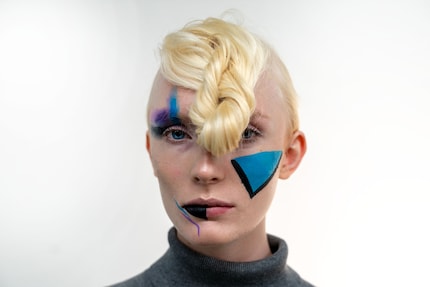
Marc is reluctant to admit defeat. In fact, after a short time, the Nex gives up when it sees Lea in profile with the gaudy triangle and the quiff on her nose. People don't have triangles on their faces or two nose tips. But since the camera recognises Lea's other side without any problems, we can conclude: It's the triangle.
A final attempt with David, who the camera has always recognised so far. Marc adapts techniques that have already worked with Lea. Success is not long in coming, because when David's hair hangs over the critical area between his eyes, he also becomes digitally invisible.
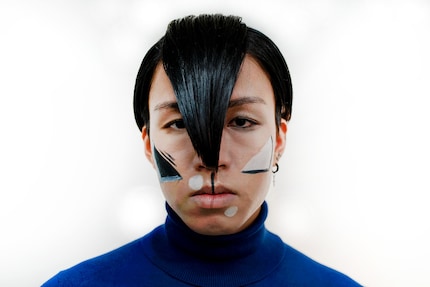
With their make-up, Lea and David stand out like colourful dogs in real life. The paradoxical effect, however, is that it is precisely their abnormal looks that make them stand out so much that a camera can no longer see anyone.
We don't know whether the experiment also works with professional cameras in stadiums or supermarkets. But what we do know: We're not breaking any laws with Lea and David's make-up. Because the ban on wearing masks applies to clothing, but not make-up.
Journalist. Author. Hacker. A storyteller searching for boundaries, secrets and taboos – putting the world to paper. Not because I can but because I can’t not.
Practical solutions for everyday problems with technology, household hacks and much more.
Show all
